
A plug-in hybrid is a car that combines the internal combustion engine and a battery-powered, electric motor. When the electric motor runs out of "fuel," it is recharged via a "clean energy grid," or plug-in.
A plug-in hybrid can be recharged using an average home's electrical current (110 volts). At this time, there are no plug-in hybrids that are w idely available to the public, but Chevrolet's Volt is an up-and-coming example of a plug-in hybrid that will soon be available to consumers.
Not all hybrid vehicles are of the plug-in variety. For example, a "full hybrid" is a car like the Toyota Prius – at low speeds, it runs on only the electric motor. When the vehicle goes over a certain speed, the internal combustion engine kicks in.
A full hybrid never uses electricity from the grid. A plug-in uses the internal combustion engine only as a back-up in case the electric motor runs out of battery power, regardless of the speed. And it uses electricity from the grid when it is charged.
Most plug-ins have a range of about 30 miles before the battery runs out and the combustion engine kicks in.
How Do They Work?
As noted above, a plug-in hybrid has two means of propelling it forward – an internal combustion engine (like a regular car) and an electric motor that runs on a battery. After each use, the car is plugged into a household current and charged. If you forget to plug it in or end up with a dying battery while on the road, the internal combustion engine will kick in. You can keep driving and the internal combustion engine will charge the battery. At this point, the plug-in hybrid is acting like a standard or full hybrid.
Because they reduce emissions and gasoline use so drastically, many people are hoping for plug-in hybrids to become more widely available. But the enormous cost of the lithium-ion batteries required to run the plug-ins makes them somewhat cost prohibitive. The Chevrolet Volt is said to require a 400-pound battery.
Plug-in hybrids are laid out like other hybrids in that they have a continuously variable transmission (CVT) that makes the transition from combustion engine to electric motor smooth. Plug-ins, like other hybrids, also shut off automatically at stop lights and start again when the driver takes his or her foot off the brake pedal. This reduces energy loss during idling.

